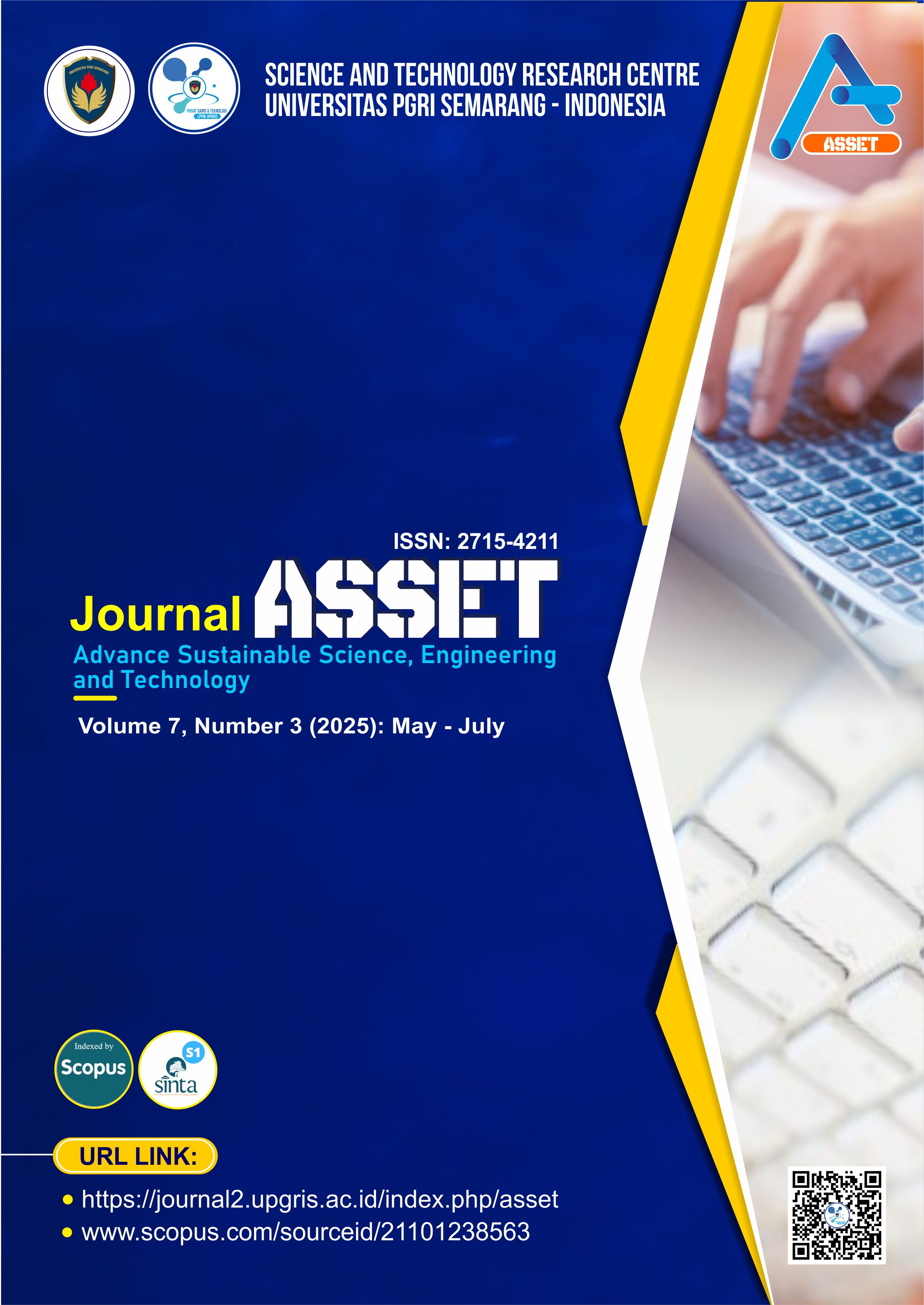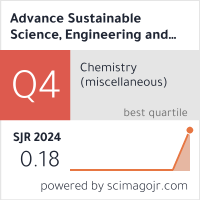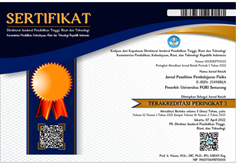Evaluating Sustainable Waste Collection Models Using the Analytical Hierarchy Process (AHP): A Multi-Criteria Decision-Making Approach
DOI:
https://doi.org/10.26877/asset.v7i3.1471Keywords:
AHP model, decision-making process, diaper waste collection, multi-criteria analysis, sustainability assessmentAbstract
The growing issue of disposable baby diaper waste requires an effective collection model to support sustainable waste management. This study designs a community-based collection model using the Analytical Hierarchy Process (AHP) method to identify the most effective approach. Three models are evaluated: Model 1 (Community-Based Diaper Bank), Model 2 (Scheduled Diaper Pick-Up Program), and Model 3 (Diaper Collection Points at Public Facilities). Results show Model 1 is the most effective, with the highest Global Priority score of 0.415, due to its contributions to reducing environmental impact, raising public awareness, and incentivizing participation. Model 2 and Model 3 follow with scores of 0.353 and 0.261. The environmental criterion holds the highest weight (0.504), emphasizing its importance. These findings suggest that community-based models can enhance waste collection efficiency and support sustainability. The results can inform policy development and help guide future research on sustainable waste management practices.
References
[1] D. A. Melati and F. N. Na’im, “Online community impact to reduce diaper waste in Indonesia (study case at mamaberclodi community),” Interact. Community Engag. Soc. Environ., vol. 1, no. 1, pp. 52–66, 2023, doi: 10.61511/icese.v1i1.2023.248.
[2] S. Purwati, N. Oktyajati, S. Mukarromah, R. A. Saputra, and I. W. Febriansyah, “Training on Utilization of Baby Diaper Waste into Resin Handicraft Products to Improve Community Economy,” Jati Emas (Jurnal Apl. Tek. dan Pengabdi. Masyarakat), vol. 8, no. 4, pp. 6–9, 2024.
[3] M. E. M. E. Ntekpe et al., “Disposable Diapers: Impact of Disposal Methods on Public Health and the Environment OPEN ACCESS,” Am. J. Med. Public Heal., vol. 1, no. 2, pp. 1–7, 2020.
[4] S. Purwati, N. Oktyajati, and I. S. Bila, “Tingkat Kesediaan dan Ekspektasi Kompensasi Konsumen dalam Pengumpulan Limbah Popok Bayi,” vol. 13, no. 1, 2024.
[5] N. A. I. Paranita, “Pengenalan Pengolahan Sampah Popok menjadi Media Tanaman Hias dalam Pemberdayaan Masyarakat untuk Pengelolaan Limbah Rumah Tangga,” J. Pengabdian, Riset, Kreat. Inovasi, dan Teknol. Tepat Guna, vol. 1, no. 2, pp. 46–54, 2023, doi: 10.22146/parikesit.v1i2.9613.
[6] N. A. A. Abus, A. Suriadi, T. Lubis, A. A. Abus, and A. F. Abus, “Waste Bank management as an alternative community-based waste management strategy in Langsa City, Aceh Province,” IOP Conf. Ser. Earth Environ. Sci., vol. 1375, no. 1, 2024, doi: 10.1088/1755-1315/1375/1/012007.
[7] Arwin Sanjaya et al., “Pemanfaatan Bank Sampah dalam Meningkatkan Kesejahterahan Masyarakat Desa Kersik,” Int. J. Community Serv. Learn., vol. 7, no. 1, pp. 1–10, 2023, doi: 10.23887/ijcsl.v7i1.56668.
[8] H. D. Purba, C. Meidiana, and D. W. Adrianto, “Waste Management Scenario through Community Based Waste Bank: A Case Study of Kepanjen District, Malang Regency, Indonesia,” Int. J. Environ. Sci. Dev., vol. 5, no. 2, pp. 212–216, 2014, doi: 10.7763/ijesd.2014.v5.480.
[9] S. Amalia, “Social Capital in Community-Based Waste Bank Management,” J. Ilmu Sos., vol. 18, no. 2, pp. 93–108, 2019, doi: 10.14710/jis.18.2.2019.93.
[10] A. Aprilia, “Waste Management in Indonesia and Jakarta: Challenges and Way Forward,” Backgr. Pap. 23rd ASEF Summer Univ. ASEF Educ. Dep. Oct. 2021, no. October, pp. 1–18, 2021, [Online]. Available: https://asef.org/wp-content/uploads/2022/01/ASEFSU23_Background-Paper_Waste-Management-in-Indonesia-and-Jakarta.pdf
[11] A. Pangarso et al., “Sistem penjemputan sampah untuk pengelolaan sampah terpadu di Komunitas Muda Berseri,” Riau J. Empower., vol. 5, no. 3, pp. 163–174, 2022, doi: 10.31258/raje.5.3.163-174.
[12] D. J. Moosom and M. Z. M. Noor, Integrating Urban Strategies For Waste Collection Facilities In Urban Public Space. 2023.
[13] M. Ridha, D. Rohmat, and W. Kastolani, “Waste collecting point as the school of the waste management system,” IOP Conf. Ser. Earth Environ. Sci., vol. 683, no. 1, 2021, doi: 10.1088/1755-1315/683/1/012015.
[14] H. Puspasari, Y. Yusuf, and I. A. Kurniawan, “Kolaborasi Berbasis Masyarakat Dalam Pengelolaan Sampah Popok Bayi Oleh Komunitas Sarana Olah Sampah Di Kota Tangerang,” J. Ilm. Ilmu Adm., vol. 12, no. 2, pp. 115–127, 2022, doi: 10.33592/jiia.v12i2.3218.
[15] P. Chompook, J. Roemmontri, and A. Ketsakorn, “the Application of Analytic Hierarchy Process (Ahp) for Selecting Community Problems: Multicriteria Decision-Making Approach on Environmental Health Aspects,” J. Sustain. Sci. Manag., vol. 18, no. 10, pp. 138–149, 2023, doi: 10.46754/jssm.2023.10.009.
[16] M. J. X. Belem, M. V. Junior, G. Mummolo, and F. Facchini, “An ahp‐based procedure for model selection for eco‐efficiency assessment,” Sustain., vol. 13, no. 21, pp. 1–21, 2021, doi: 10.3390/su132112121.
[17] M. Gunamantha, M. V. Oviantari, and N. W. Yuningrat, “The application of the analytical hierarchy process (AHP) in determining organic waste process technology-oriented-reducing greenhouse gas,” E3S Web Conf., vol. 467, pp. 1–6, 2023, doi: 10.1051/e3sconf/202346704006.
[18] A. Yulda, T. Nurcihikita, and Y. Efriyandi, “Analysis of Circular Economy Potential in Waste Management : Operational Efficiency and Economic Impact at TPS3R Bungo Lintas,” vol. 5, no. 4, pp. 3993–4010, 2024.
[19] A. Johari, H. Alkali, H. Hashim, S. I. Ahmed, and R. Mat, “Municipal solid waste management and potential revenue from recycling in Malaysia,” Mod. Appl. Sci., vol. 8, no. 4, pp. 37–49, 2014, doi: 10.5539/mas.v8n4p37.
[20] J. P. Doussoulin and C. Colther, “Evaluating the Efficiency of Municipal Solid Waste Collection Services in Developing Countries: The Case of Chile,” Sustain., vol. 14, no. 23, pp. 1–19, 2022, doi: 10.3390/su142315887.
[21] R. O. Ampong, K. Miezah, A. Banunle, E. E. Y. Amuah, and E. G. Amoah, “Comparative analysis of the effectiveness and efficiency of formal and informal waste collectors in urban waste management system,” Heliyon, vol. 10, no. 20, p. e39017, 2024, doi: 10.1016/j.heliyon.2024.e39017.
[22] C. O. Ugwu, C. G. Ozoegwu, P. A. Ozor, N. Agwu, and C. Mbohwa, “Waste reduction and utilization strategies to improve municipal solid waste management on Nigerian campuses,” Fuel Commun., vol. 9, p. 100025, 2021, doi: 10.1016/j.jfueco.2021.100025.
[23] W. Shi et al., “How Environmental Regulation Affects Pollution Reduction and Carbon Reduction Synergies—An Empirical Analysis Based on Chinese Provincial Data,” Sustain. , vol. 16, no. 13, 2024, doi: 10.3390/su16135331.
[24] M. J. Siregar, “Recent Technology for Recycling of Used Diapers Waste,” Int. J. Innov. Eng., vol. 2, no. 2, pp. 13–25, 2022, doi: 10.59615/ijie.2.2.13.
[25] Y. A. K. N. S. N. J. O. H. Lanita Winata, “A Model of Waste Management Improvement in Indonesia,” J. Akunt., vol. 23, no. 3, p. 393, 2020, doi: 10.24912/ja.v23i3.604.
[26] A. F. Yasin and N. Abu, “Gerakan Pungut Sampah (GPS) Sebagai Upaya Membangun Kesadaran Lingkungan (Studi Kasus Kelurahan Kampung Baru Kota Sorong,” AMMA J. Pengabdi. Masy., vol. 2, no. 10, pp. 1193–1203, 2023.
[27] H. M. Ali, C. Sitinjak, M. H. Md Said, J. Z. Hassim, R. Ismail, and V. Simic, “Model predicting social acceptance behavior to implement ELV policy: Exploring the role of knowledge toward ELV policy on social acceptance in Malaysia,” Front. Public Heal., vol. 10, 2023, doi: 10.3389/fpubh.2022.1093732.











